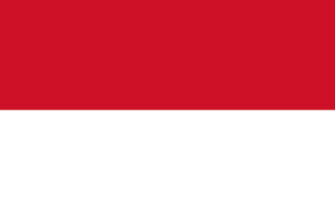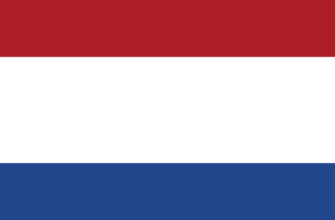The German state has its origins in the ninth century AD. A century later — in 962 — the «Holy Roman Empire» (First Reich) was founded, which in the Middle Ages acquired a slightly different name — the «Holy Roman Empire of the German (Germanic) Nation. The millennial Reich disintegrated in 1806 into many small kingdoms. The German Empire (Second Reich), created in 1871, lasted just under half a century and disintegrated at the end of World War I. The Third Reich was proclaimed by the Nazis in 1933 and died out 12 years later.
This is what the modern German flag looks like:

- History of German flags
- Holy Roman Empire of the German Nation 1410-1806
- Rhenish Union 1806-1813
- German Union 1848-1852
- North German Union 1868-1870
- German Empire 1870-1919
- Weimar Republic 1919-1933
- Nazi Germany 1933-1945
- Postwar Germany 1945-1949
- German Democratic Republic 1949-1990
- Description
- Flag colors
- Meaning of colors and flag symbol
- General information about Germany
- Map of Germany
History of German flags
The flag of present-day Germany was officially adopted in May 1949. In the history of the Germans there were cases when this version of the symbol of the country was abolished. First it was during the German Empire, and then during the Nazis. The history of the state symbol has undergone its own changes, but the colors used on the modern cloth have always been predominant.
Holy Roman Empire of the German Nation 1410-1806

















Rhenish Union 1806-1813


German Union 1848-1852
During the Napoleonic struggle, student volunteers invented their own uniforms:
- black uniform;
- red epaulettes;
- golden (brass) buttons.
Founded in 1813, the «Freedom Corps» already formed three years later into a student association, which came up with its own flag in the form of three stripes: black, red and gold. The same flag was raised for the first time during the revolution of 1848-1849 as the symbol of a united Germany. The hopes and aspirations of the Germans to revive the empire in those years were not realized. The German alliance failed. The large states represented by Austria and Prussia refused to recognize the rebirth of the new empire, and everything ended in nothing.


Nevertheless, the combination of the three colors stuck and became perceived with the concept of Germanic identity.
North German Union 1868-1870







German Empire 1870-1919






The Austrian Empire at the time of the creation of the Second Reich did not become part of it, but united with Hungary to form the Austro-Hungarian Empire, which, like the German Empire, collapsed at the end of World War I. All the fragments of the First Reich that subsequently became part of the new German Empire ceased to exist as a sovereign entity in 1918, following Germany’s defeat in World War I.
Weimar Republic 1919-1933



Nazi Germany 1933-1945
Hitler’s Germany did not abandon the color scheme of the German Empire (black, white and red). As is known, the same colors were used on the cloth of that period, although reworked in its own way. Hitler deliberately used the color combination of the Second Reich in order to attract the conservative-minded bourgeoisie and monarchists to his side.




On the territory of the former «Holy Roman Empire of the German (German) Nation» many kingdoms and states existed or emerged, each with its own symbol.
Postwar Germany 1945-1949

German Democratic Republic 1949-1990
Even in the German Democratic Republic (GDR 1949-1989) did not abandon the historical colors, adding only the country’s coat of arms to the center.

The Federal Republic of Germany is the modern form of German statehood. Since its unification with the GDR in 1990 its administrative division consists of sixteen states. These are historical territories which have retained their names. They all have their own symbols, which have either been retained in their original form or slightly altered.
Description
The national symbol of Germany has a rectangular form, with horizontal even stripes of three colors: black, red and gold. The proportions of the cloth are 3 to 5. The width of each of the stripes is equal to 1/3 of the entire width of the flag. The black stripe is at the top, the red stripe in the middle, and the gold stripe at the bottom.
Flag colors
The German flag consists of three colors: black, red, and gold. These are the traditional colors of the German state, which have come down to this day from the depths of time.
Meaning of colors and flag symbol
Black and yellow (golden) are known to have been used as early as the middle of the last millennium. These colors for the Germans symbolized:
- black — the historical past, the power and courage of Germany;
- Gold — joyful future;
- red — the blood shed by the Germans in different periods of Germany’s great history.
In addition to this interpretation of colors, another interpretation is used, in which black is not just the past, but the dark past.
According to German law, the state symbol is used only by state institutions. In case of illegal use there is a fine of 1 thousand euros. In addition, the state symbols are prohibited for use for commercial purposes. However, the colors of the flag are allowed to be used for any purpose.
The symbol is protected from defamation and insults, in which case the perpetrator is punished by a large fine and imprisonment of up to three years.
A German citizen has the right to keep the national flag and to display it.
General information about Germany
| Official language | German |
| Capital | Berlin |
| Territory | 357 385 km2 |
| Population | 83 019 200 people |
| Currency | Euro (EUR, code 978) |
| Phone Code | +49 |










I remember when I visited Germany and saw the flag everywhere. It felt like a symbol of pride during the World Cup. Each time I saw it waving, I couldn’t help but feel the excitement of the fans and the unity it brought to everyone around.
I remember my trip to Germany, standing in front of the Brandenburg Gate with the German flag waving proudly. It was such a beautiful sight! The history and culture made me appreciate their heritage. I’m grateful for that experience; it truly opened my eyes to the world!
That sounds amazing! When I visited Italy, standing by the Colosseum gave me the same vibe—history literally all around. It’s wild how visiting a place can turn abstract facts into real, lived moments. Travel definitely rewires your perspective and appreciation for culture.
I remember visiting Germany and seeing the flag everywhere! It made me feel the pride and history of the country. I even took a photo with a local who was waving it at a festival. Such a fun experience, and the colors just pop!
I totally get that feeling! When I visited Italy, the Italian flag was everywhere too. It really does amp up the vibe at festivals. I took a selfie with some locals, and the energy was contagious. It’s like you can feel the culture and pride all around you!
As a guy who loves travel, the German flag always reminds me of my trip to Berlin. The colors really stand out, and I remember feeling a strong vibe of unity and history everywhere. It’s amazing how flags can tell such cool stories without saying a word!
Totally get that! On my trip to Berlin, the black-red-gold combo felt like a symbol of resilience. Walking through the city, you could almost hear history whispering. Flags do pack a punch, representing so much more than just colors—like a silent storyteller connecting us to the past.
Totally get that, Brian! I once visited Berlin too, and standing by the Brandenburg Gate gave me chills—the flag there really felt like a symbol of resilience. Flags pack so much meaning; they’re like gateways to the past and present blended into one symbol.